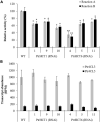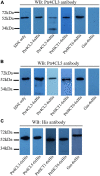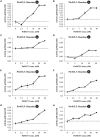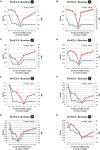Enzyme Complexes of Ptr4CL and PtrHCT Modulate Co-enzyme A Ligation of Hydroxycinnamic Acids for Monolignol Biosynthesis in Populus trichocarpa
- PMID: 34691108
- PMCID: PMC8527181
- DOI: 10.3389/fpls.2021.727932
Enzyme Complexes of Ptr4CL and PtrHCT Modulate Co-enzyme A Ligation of Hydroxycinnamic Acids for Monolignol Biosynthesis in Populus trichocarpa
Abstract
Co-enzyme A (CoA) ligation of hydroxycinnamic acids by 4-coumaric acid:CoA ligase (4CL) is a critical step in the biosynthesis of monolignols. Perturbation of 4CL activity significantly impacts the lignin content of diverse plant species. In Populus trichocarpa, two well-studied xylem-specific Ptr4CLs (Ptr4CL3 and Ptr4CL5) catalyze the CoA ligation of 4-coumaric acid to 4-coumaroyl-CoA and caffeic acid to caffeoyl-CoA. Subsequently, two 4-hydroxycinnamoyl-CoA:shikimic acid hydroxycinnamoyl transferases (PtrHCT1 and PtrHCT6) mediate the conversion of 4-coumaroyl-CoA to caffeoyl-CoA. Here, we show that the CoA ligation of 4-coumaric and caffeic acids is modulated by Ptr4CL/PtrHCT protein complexes. Downregulation of PtrHCTs reduced Ptr4CL activities in the stem-differentiating xylem (SDX) of transgenic P. trichocarpa. The Ptr4CL/PtrHCT interactions were then validated in vivo using biomolecular fluorescence complementation (BiFC) and protein pull-down assays in P. trichocarpa SDX extracts. Enzyme activity assays using recombinant proteins of Ptr4CL and PtrHCT showed elevated CoA ligation activity for Ptr4CL when supplemented with PtrHCT. Numerical analyses based on an evolutionary computation of the CoA ligation activity estimated the stoichiometry of the protein complex to consist of one Ptr4CL and two PtrHCTs, which was experimentally confirmed by chemical cross-linking using SDX plant protein extracts and recombinant proteins. Based on these results, we propose that Ptr4CL/PtrHCT complexes modulate the metabolic flux of CoA ligation for monolignol biosynthesis during wood formation in P. trichocarpa.
Keywords: BiFC; Populus trichocarpa; metabolic flux; monolignol biosynthesis; protein interaction; wood formation.
Copyright © 2021 Lin, Sun, Song, Chen, Shi, Yang, Liu, Tunlaya-Anukit, Liu, Loziuk, Williams, Muddiman, Lin, Sederoff, Wang and Chiang.
Conflict of interest statement
The authors declare that the research was conducted in the absence of any commercial or financial relationships that could be construed as a potential conflict of interest.
Figures








Similar articles
-
4-Coumaroyl and caffeoyl shikimic acids inhibit 4-coumaric acid:coenzyme A ligases and modulate metabolic flux for 3-hydroxylation in monolignol biosynthesis of Populus trichocarpa.Mol Plant. 2015 Jan;8(1):176-87. doi: 10.1016/j.molp.2014.12.003. Epub 2014 Dec 11. Mol Plant. 2015. PMID: 25578281
-
4-Coumaroyl and Caffeoyl Shikimic Acids Inhibit 4-Coumaric Acid: Coenzyme A Ligases and Modulate Metabolic Flux for 3-Hydroxylation in Monolignol Biosynthesis of Populus trichocarpa.Mol Plant. 2014 Oct 20:ssu117. doi: 10.1093/mp/ssu117. Online ahead of print. Mol Plant. 2014. PMID: 25336570
-
Monolignol pathway 4-coumaric acid:coenzyme A ligases in Populus trichocarpa: novel specificity, metabolic regulation, and simulation of coenzyme A ligation fluxes.Plant Physiol. 2013 Mar;161(3):1501-16. doi: 10.1104/pp.112.210971. Epub 2013 Jan 23. Plant Physiol. 2013. PMID: 23344904 Free PMC article.
-
Enzyme-Enzyme Interactions in Monolignol Biosynthesis.Front Plant Sci. 2019 Jan 11;9:1942. doi: 10.3389/fpls.2018.01942. eCollection 2018. Front Plant Sci. 2019. PMID: 30693007 Free PMC article. Review.
-
Trends in lignin modification: a comprehensive analysis of the effects of genetic manipulations/mutations on lignification and vascular integrity.Phytochemistry. 2002 Oct;61(3):221-94. doi: 10.1016/s0031-9422(02)00211-x. Phytochemistry. 2002. PMID: 12359514 Review.
Cited by
-
Genome-edited rice deficient in two 4-COUMARATE:COENZYME A LIGASE genes displays diverse lignin alterations.Plant Physiol. 2022 Nov 28;190(4):2155-2172. doi: 10.1093/plphys/kiac450. Plant Physiol. 2022. PMID: 36149320 Free PMC article.
-
Molecular cloning and functional analysis of 4-coumarate: CoA ligases from Marchantia paleacea and their roles in lignin and flavanone biosynthesis.PLoS One. 2024 Jan 8;19(1):e0296079. doi: 10.1371/journal.pone.0296079. eCollection 2024. PLoS One. 2024. PMID: 38190396 Free PMC article.
-
Dual feedback inhibition of ATP-dependent caffeate activation economizes ATP in caffeate-dependent electron bifurcation.Appl Environ Microbiol. 2024 Sep 18;90(9):e0060224. doi: 10.1128/aem.00602-24. Epub 2024 Aug 23. Appl Environ Microbiol. 2024. PMID: 39177329 Free PMC article.
-
Deciphering the intricate hierarchical gene regulatory network: unraveling multi-level regulation and modifications driving secondary cell wall formation.Hortic Res. 2023 Dec 19;11(2):uhad281. doi: 10.1093/hr/uhad281. eCollection 2024 Feb. Hortic Res. 2023. PMID: 38344650 Free PMC article.
-
Class I and II NADPH-cytochrome P450 reductases exhibit different roles in triterpenoid biosynthesis in Lotus japonicus.Front Plant Sci. 2023 Aug 9;14:1214602. doi: 10.3389/fpls.2023.1214602. eCollection 2023. Front Plant Sci. 2023. PMID: 37621889 Free PMC article.
References
-
- Albersheim P., Darvill A., Roberts K., Sederoff R., Staehelin A. (2010). “The structural polysaccharides of the cell wall and how they are studied,” in Plant Cell Walls, (New York, NY: Taylor & Francis Group; ), 61–84. 10.1201/9780203833476-6 - DOI
-
- Barrière Y., Riboulet C., Méchin V., Maltese S., Pichon M., Cardinal A., et al. (2007). Genetics and genomics of lignification in grass cell walls based on maize as model species. Genes Genomes Genomics 1 133–156.
LinkOut - more resources
Full Text Sources

